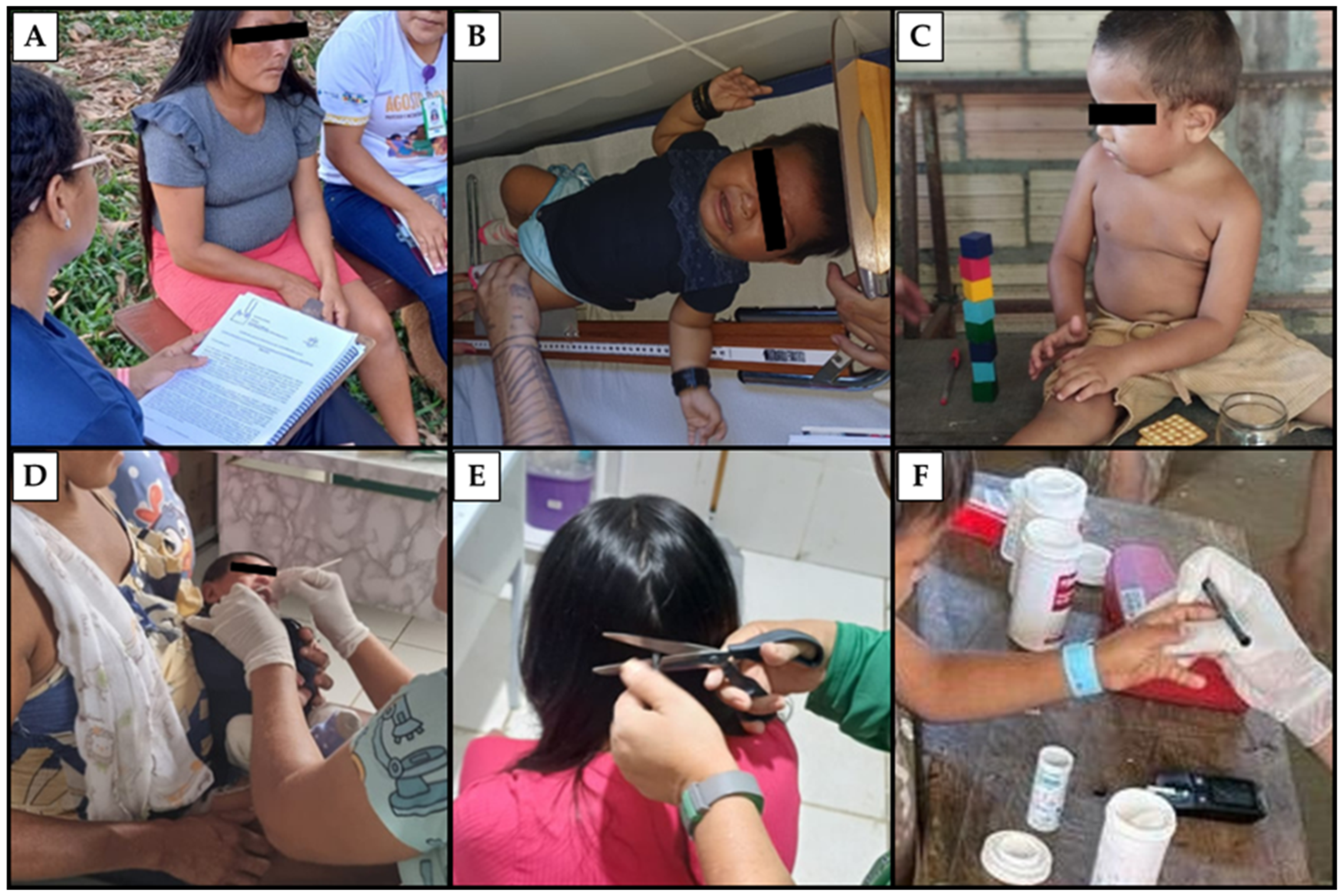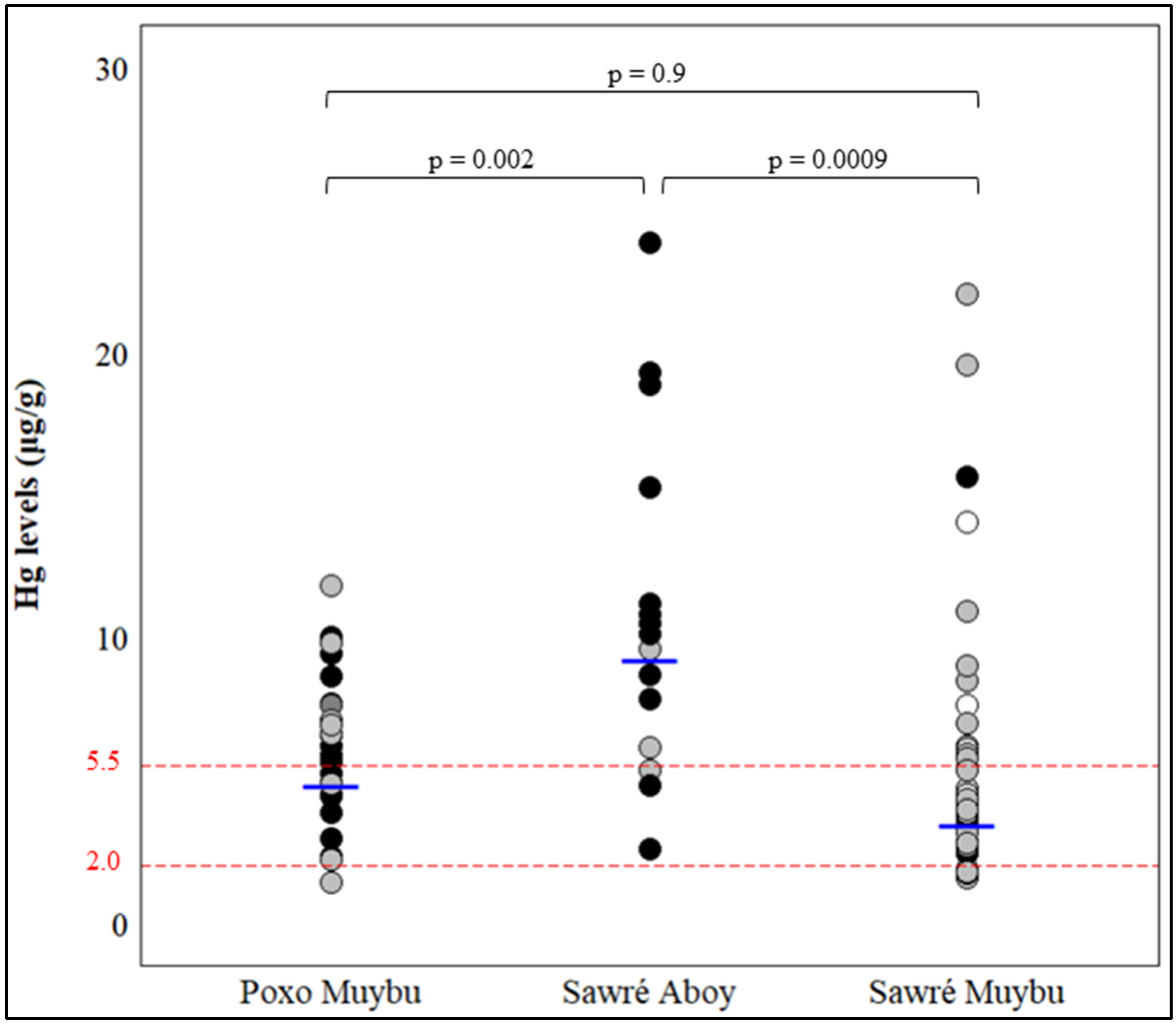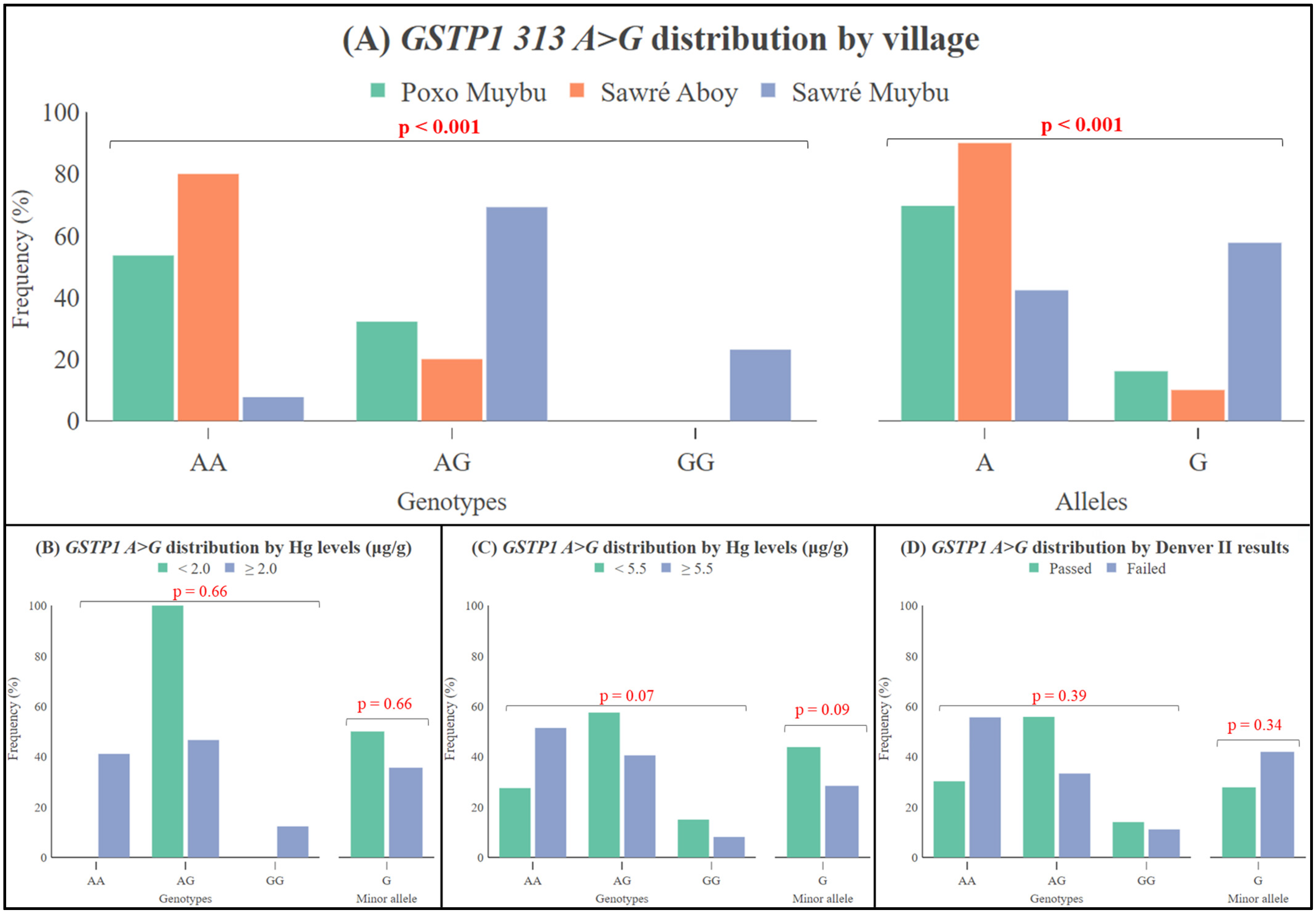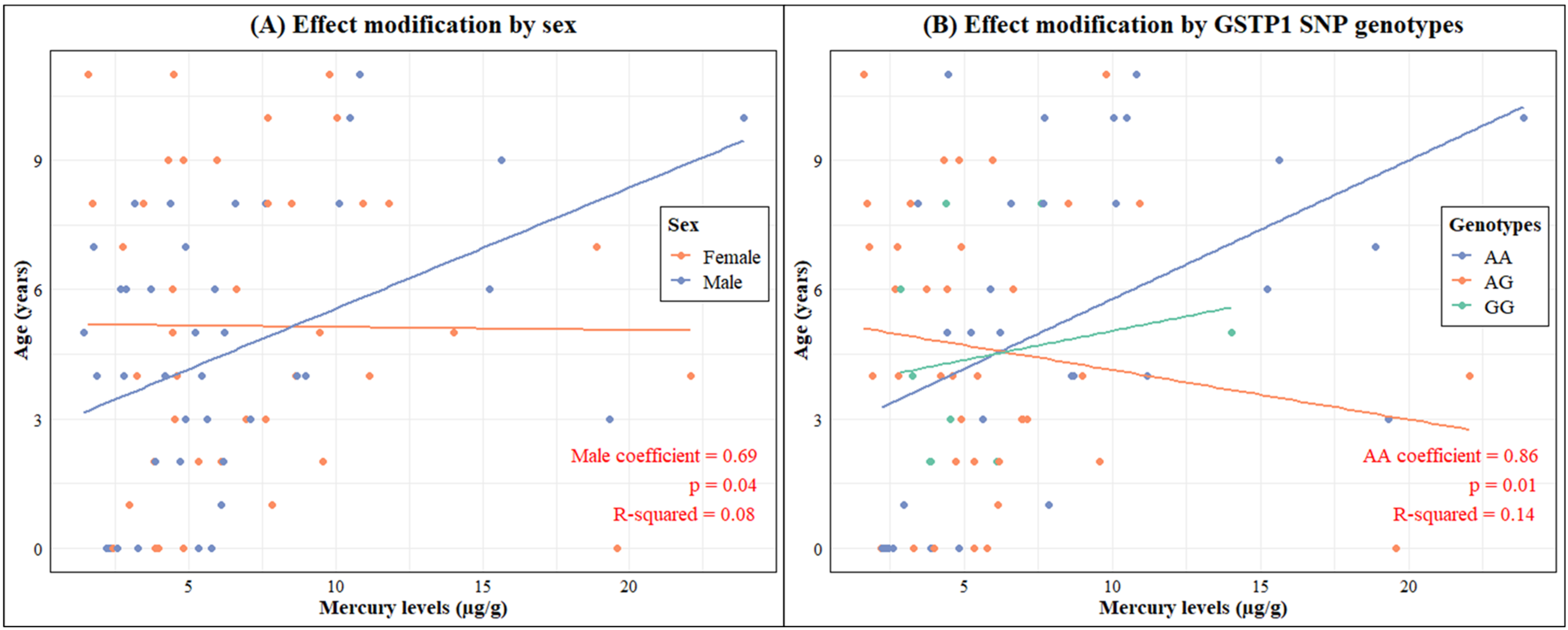The GSTP1 rs1695 Polymorphism Is Associated with Mercury Levels and Neurodevelopmental Delay in Indigenous Munduruku Children from the Brazilian Amazon
Abstract
1. Introduction
2. Materials and Methods
2.1. Study Design and Population
2.2. Clinical and Pediatric Evaluation
2.3. Hair Mercury Analysis
2.4. DNA Extraction and GSTP1 Genotyping
2.5. Data Analysis
3. Results
4. Discussion
5. Conclusions
Supplementary Materials
Author Contributions
Funding
Institutional Review Board Statement
Informed Consent Statement
Data Availability Statement
Acknowledgments
Conflicts of Interest
References
- Siqueira-Gay, J.; Sánchez, L.E. The outbreak of illegal gold mining in the Brazilian Amazon boosts deforestation. Reg. Environ. Chang. 2021, 21, 28. [Google Scholar] [CrossRef]
- de Lacerda, L. Updating global Hg emissions from small-scale gold mining and assessing its environmental impacts. Environ. Geol. 2003, 43, 308–314. [Google Scholar] [CrossRef]
- Rice, K.M.; Walker, E.M.; Wu, M.; Gillette, C.; Blough, E.R. Environmental Mercury and Its Toxic Effects. J. Prev. Med. Public Health 2014, 47, 74–83. [Google Scholar] [CrossRef]
- Al-Saleh, I.; Elkhatib, R.; Al-Rouqi, R.; Abduljabbar, M.; Eltabache, C.; Al-Rajudi, T.; Nester, M. Alterations in biochemical markers due to mercury (Hg) exposure and its influence on infant’s neurodevelopment. Int. J. Hyg. Environ. Health 2016, 219, 898–914. [Google Scholar] [CrossRef] [PubMed]
- de Vasconcellos, A.C.S.; Barrocas, P.R.G.; Ruiz, C.M.V.; Mourão, D.d.S.; Hacon, S.d.S. Burden of Mild Mental Retardation attributed to prenatal methylmercury exposure in Amazon: Local and regional estimates. Cienc. Saude Coletiva 2018, 23, 3535–3545. [Google Scholar] [CrossRef] [PubMed]
- Araujo, M.S.d.A.; Froes-Asmus, C.I.R.; de Figueiredo, N.D.; Camara, V.M.; Luiz, R.R.; Prata-Barbosa, A.; Martins, M.M.; Jacob, S.D.C.; dos Santos, L.M.G.; Neto, S.A.V.; et al. Prenatal Exposure to Metals and Neurodevelopment in Infants at Six Months: Rio Birth Cohort Study of Environmental Exposure and Childhood Development (PIPA Project). Int. J. Environ. Res. Public Health 2022, 19, 4295. [Google Scholar] [CrossRef]
- Pinheiro, M.d.C.N.; Nascimento, J.L.M.D.; Silveira, L.C.d.L.; da Rocha, J.B.T.; Aschner, M. Mercury and Selenium—A Review on Aspects Related to the Health of Human Populations in the Amazon. Environ. Bioindic. 2009, 4, 222–245. [Google Scholar] [CrossRef]
- Basta, P.C.; Viana, P.V.d.S.; de Vasconcellos, A.C.S.; Périssé, A.R.S.; Hofer, C.B.; Paiva, N.S.; Kempton, J.W.; de Andrade, D.C.; de Oliveira, R.A.A.; Achatz, R.W.; et al. Mercury Exposure in Munduruku Indigenous Communities from Brazilian Amazon: Methodological Background and an Overview of the Principal Results. Int. J. Environ. Res. Public Health 2021, 18, 9222. [Google Scholar] [CrossRef]
- Basta, P.C. Garimpo de ouro na Amazônia: A origem da crise sanitária Yanomami. Cad. Saúde Pública 2023, 39, e00111823. [Google Scholar] [CrossRef]
- Vega, C.M.; Orellana, J.D.; Oliveira, M.W.; Hacon, S.S.; Basta, P.C. Human Mercury Exposure in Yanomami Indigenous Villages from the Brazilian Amazon. Int. J. Environ. Res. Public Health 2018, 15, 1051. [Google Scholar] [CrossRef]
- Achatz, R.W.; de Vasconcellos, A.C.S.; Pereira, L.; Viana, P.V.d.S.; Basta, P.C. Impacts of the Goldmining and Chronic Methylmercury Exposure on the Good-Living and Mental Health of Munduruku Native Communities in the Amazon Basin. Int. J. Environ. Res. Public Health 2021, 18, 8994. [Google Scholar] [CrossRef] [PubMed]
- Lozano, M.; Murcia, M.; Soler-Blasco, R.; González, L.; Iriarte, G.; Rebagliato, M.; Lopez-Espinosa, M.-J.; Esplugues, A.; Ballester, F.; Llop, S. Exposure to mercury among 9-year-old children and neurobehavioural function. Environ. Int. 2021, 146, 106173. [Google Scholar] [CrossRef] [PubMed]
- De la Ossa, C.A.; Ramírez-Giraldo, A.F.; Arroyo-Alvis, K.; Marrugo-Negrete, J.; Díez, S. Neuropsychological effects and cognitive deficits associated with exposure to mercury and arsenic in children and adolescents of the Mojana region, Colombia. Environ. Res. 2023, 216, 114467. [Google Scholar] [CrossRef] [PubMed]
- Perini, J.A.; Silva, M.C.; de Vasconcellos, A.C.S.; Viana, P.V.S.; Lima, M.O.; Jesus, I.M.; Kempton, J.W.; Oliveira, R.A.A.; Hacon, S.S.; Basta, P.C. Genetic Polymorphism of Delta Aminolevulinic Acid Dehydratase (ALAD) Gene and Symptoms of Chronic Mercury Exposure in Munduruku Indigenous Children within the Brazilian Amazon. Int. J. Environ. Res. Public Health 2021, 18, 8746. [Google Scholar] [CrossRef] [PubMed]
- da Silva, M.C.; de Oliveira, R.A.A.; de Vasconcellos, A.C.S.; Rebouças, B.H.; Pinto, B.D.; Lima, M.d.O.; de Jesus, I.M.; Machado, D.E.; Hacon, S.S.; Basta, P.C.; et al. Chronic Mercury Exposure and GSTP1 Polymorphism in Munduruku Indigenous from Brazilian Amazon. Toxics 2023, 11, 138. [Google Scholar] [CrossRef]
- de Oliveira, R.A.A.; Pinto, B.D.; Rebouças, B.H.; de Andrade, D.C.; de Vasconcellos, A.C.S.; Basta, P.C. Neurological Impacts of Chronic Methylmercury Exposure in Munduruku Indigenous Adults: Somatosensory, Motor, and Cognitive Abnormalities. Int. J. Environ. Res. Public Health 2021, 18, 10270. [Google Scholar] [CrossRef] [PubMed]
- Rebouças, B.H.; Kubota, G.T.; Oliveira, R.A.A.; Pinto, B.D.; Cardoso, R.M.; Vasconcellos, A.C.S.; Basta, P.C. Long-Term Environmental Methylmercury Exposure Is Associated with Peripheral Neuropathy and Cognitive Impairment among an Amazon Indigenous Population. Toxics 2024, 12, 212. [Google Scholar] [CrossRef]
- Vélez-Agosto, N.M.; Soto-Crespo, J.G.; Vizcarrondo-Oppenheimer, M.; Vega-Molina, S.; Coll, C.G. Bronfenbrenner’s Bioecological Theory Revision: Moving Culture From the Macro Into the Micro. Perspect. Psychol. Sci. 2017, 12, 900–910. [Google Scholar] [CrossRef] [PubMed]
- Walker, S.P.; Wachs, T.D.; Grantham-McGregor, S.; Black, M.M.; Nelson, C.A.; Huffman, S.L.; Baker-Henningham, H.; Chang, S.M.; Hamadani, J.D.; Lozoff, B.; et al. Inequality in early childhood: Risk and protective factors for early child development. Lancet 2011, 378, 1325–1338. [Google Scholar] [CrossRef]
- LeWinn, K.Z.; Bush, N.R.; Batra, A.; Tylavsky, F.; Rehkopf, D. Identification of Modifiable Social and Behavioral Factors Associated With Childhood Cognitive Performance. JAMA Pediatr. 2020, 174, 1063–1072. [Google Scholar] [CrossRef]
- Jacques, A.D.; de Oliveira, M.A.F.; da Silva, M.C.; Hofer, C.B.; Basta, P.C. Clinical, Laboratory and Neurodevelopmental Findings in Children from the Yanomami-Ninam Population Chronically Exposed to Methylmercury. Toxics 2024, 12, 193. [Google Scholar] [CrossRef] [PubMed]
- Mollon, J.; Knowles, E.E.M.; Mathias, S.R.; Gur, R.; Peralta, J.M.; Weiner, D.J.; Robinson, E.B.; Gur, R.E.; Blangero, J.; Almasy, L.; et al. Genetic influence on cognitive development between childhood and adulthood. Mol. Psychiatry 2018, 26, 656–665. [Google Scholar] [CrossRef]
- Gundacker, C.; Neesen, J.; Straka, E.; Ellinger, I.; Dolznig, H.; Hengstschläger, M. Genetics of the human placenta: Implications for toxicokinetics. Arch. Toxicol. 2016, 90, 2563–2581. [Google Scholar] [CrossRef] [PubMed]
- Chan, P.H.Y.; Chan, K.Y.Y.; Schooling, C.M.; Hui, L.L.; Chan, M.H.M.; Li, A.M.; Cheung, R.C.K.; Lam, H.S. Association between genetic variations in GSH-related and MT genes and low-dose methylmercury exposure in children and women of childbearing age: A pilot study. Environ. Res. 2020, 187, 109703. [Google Scholar] [CrossRef] [PubMed]
- Sirivarasai, J.; Chaisungnern, K.; Panpunuan, P.; Chanprasertyothin, S.; Chansirikanjana, S.; Sritara, P. Role of MT1A Polymorphism and Environmental Mercury Exposure on the Montreal Cognitive Assessment (MoCA). Neuropsychiatr. Dis. Treat. 2021, 17, 2429–2439. [Google Scholar] [CrossRef] [PubMed]
- Ballatori, N.; Clarkson, T.W. Biliary secretion of glutathione and of glutathione-metal complexes*1. Fundam. Appl. Toxicol. 1985, 5, 816–831. [Google Scholar] [CrossRef] [PubMed]
- Custodio, H.M.; Broberg, K.; Wennberg, M.; Jansson, J.-H.; Vessby, B.; Hallmans, G.; Stegmayr, B.; Skerfving, S. Polymorphisms in Glutathione-Related Genes Affect Methylmercury Retention. Arch. Environ. Health Int. J. 2004, 59, 588–595. [Google Scholar] [CrossRef]
- Weltgesundheitsorganisation. Length/Height-for-Age, Weight-for-Age, Weight-for-Length, Weight-for-Height and Body Mass Index-for-Age; Methods and Development; de Onis, M., Ed.; WHO Child Growth Standards; WHO Press: Geneva, Switzerland, 2006; ISBN 978-92-4-154693-5. [Google Scholar]
- Brasil Ministry of Health; Secretary of Health Care; Department of Primary Care. Guidelines for the Collection and Analysis of Anthropometric Data in Health Services: Technical Standard of the Food and Nutritional Surveillance System—SISVAN; Series G. Statistics and Health Information; Ministry of Health: Brasília, Brazil, 2011; ISBN 978-85-334-1813-4. [Google Scholar]
- Kempton, J.W.; Périssé, A.R.S.; Hofer, C.B.; de Vasconcellos, A.C.S.; Viana, P.V.d.S.; Lima, M.d.O.; de Jesus, I.M.; Hacon, S.d.S.; Basta, P.C. An Assessment of Health Outcomes and Methylmercury Exposure in Munduruku Indigenous Women of Childbearing Age and Their Children under 2 Years Old. Int. J. Environ. Res. Public Health 2021, 18, 10091. [Google Scholar] [CrossRef]
- Santos, J.A.T.; Ayupe, K.M.A.; Lima, A.L.O.; de Albuquerque, K.A.; Morgado, F.F.d.R.; Filho, P.J.B.G. Propriedades psicométricas da versão brasileira do Denver II: Teste de triagem do desenvolvimento. Ciência Saúde Coletiva 2022, 27, 1097–1106. [Google Scholar] [CrossRef]
- Sabatés, A.L. Denver II: Teste de Triagem do Desenvolvimento: Manual de Treinamento, 1st ed.; Hogrefe: São Paulo, Brazil, 2017; ISBN 978-85-85439-60-6. [Google Scholar]
- Koenigsmark, F.; Weinhouse, C.; Berky, A.J.; Morales, A.M.; Ortiz, E.J.; Pierce, E.M.; Pan, W.K.; Hsu-Kim, H. Efficacy of Hair Total Mercury Content as a Biomarker of Methylmercury Exposure to Communities in the Area of Artisanal and Small-Scale Gold Mining in Madre de Dios, Peru. Int. J. Environ. Res. Public Health 2021, 18, 13350. [Google Scholar] [CrossRef]
- UNEP; Internationale Arbeitsorganisation; Weltgesundheitsorganisation (Eds.) Methylmercury; Environmental Health Criteria; Reprint; World Health Organization: Geneva, Switzerland, 1993; ISBN 978-92-4-157101-2. [Google Scholar]
- Hacon, S.d.S.; Oliveira-Da-Costa, M.; Gama, C.d.S.; Ferreira, R.; Basta, P.C.; Schramm, A.; Yokota, D. Mercury Exposure through Fish Consumption in Traditional Communities in the Brazilian Northern Amazon. Int. J. Environ. Res. Public Health 2020, 17, 5269. [Google Scholar] [CrossRef]
- de Vasconcellos, A.C.S.; Hallwass, G.; Bezerra, J.G.; Aciole, A.N.S.; Meneses, H.N.d.M.; Lima, M.d.O.; de Jesus, I.M.; Hacon, S.d.S.; Basta, P.C. Health Risk Assessment of Mercury Exposure from Fish Consumption in Munduruku Indigenous Communities in the Brazilian Amazon. Int. J. Environ. Res. Public Health 2021, 18, 7940. [Google Scholar] [CrossRef] [PubMed]
- Basta, P.C.; de Vasconcellos, A.C.S.; Hallwass, G.; Yokota, D.; Pinto, D.d.O.D.R.; de Aguiar, D.S.; de Souza, C.C.; Oliveira-Da-Costa, M. Risk Assessment of Mercury-Contaminated Fish Consumption in the Brazilian Amazon: An Ecological Study. Toxics 2023, 11, 800. [Google Scholar] [CrossRef] [PubMed]
- Hicks, C.C.; Cohen, P.J.; Graham, N.A.J.; Nash, K.L.; Allison, E.H.; D’Lima, C.; Mills, D.J.; Roscher, M.; Thilsted, S.H.; Thorne-Lyman, A.L.; et al. Harnessing global fisheries to tackle micronutrient deficiencies. Nature 2019, 574, 95–98. [Google Scholar] [CrossRef] [PubMed]
- Welch, J.R.; Ferreira, A.A.; De Souza, M.C.; Coimbra, C.E.A. Food Profiles of Indigenous Households in Brazil: Results of the First National Survey of Indigenous Peoples’ Health and Nutrition. Ecol. Food Nutr. 2021, 60, 4–24. [Google Scholar] [CrossRef] [PubMed]
- Weinhouse, C.; Ortiz, E.J.; Berky, A.J.; Bullins, P.; Hare-Grogg, J.; Rogers, L.; Morales, A.-M.; Hsu-Kim, H.; Pan, W.K. Hair Mercury Level is Associated with Anemia and Micronutrient Status in Children Living Near Artisanal and Small-Scale Gold Mining in the Peruvian Amazon. Am. J. Trop. Med. Hyg. 2017, 97, 1886–1897. [Google Scholar] [CrossRef] [PubMed]
- Vianna, A.d.S.; Câmara, V.d.M.; Barbosa, M.C.d.M.; Santos, A.; Asmus, C.I.R.F.; Luiz, R.R.; de Jesus, I.M. Exposição ao mercúrio e anemia em crianças e adolescentes de seis comunidades da Amazônia Brasileira. Cienc. Saude Coletiva 2022, 27, 1859–1871. [Google Scholar] [CrossRef] [PubMed]
- Schober, S.E.; Sinks, T.H.; Jones, R.L.; Bolger, P.M.; McDowell, M.; Osterloh, J.; Garrett, E.S.; Canady, R.A.; Dillon, C.F.; Sun, Y.; et al. Blood Mercury Levels in US Children and Women of Childbearing Age, 1999–2000. JAMA 2003, 289, 1667–1674. [Google Scholar] [CrossRef] [PubMed]
- Akira, Y.; Miyuki, M.; Masako, Y.; Noriyuki, H. Current Hair Mercury Levels in Japanese for Estimation of Methylmercury Exposure. J. Health Sci. 2004, 50, 120–125. [Google Scholar] [CrossRef]
- Marinho, J.S.; Lima, M.O.; Santos, E.C.d.O.; de Jesus, I.M.; Pinheiro, M.d.C.N.; Alves, C.N.; Muller, R.C.S. Mercury Speciation in Hair of Children in Three Communities of the Amazon, Brazil. BioMed Res. Int. 2014, 2014, 945963. [Google Scholar] [CrossRef]
- Meneses, H.D.N.d.M.; Oliveira-Da-Costa, M.; Basta, P.C.; Morais, C.G.; Pereira, R.J.B.; de Souza, S.M.S.; Hacon, S.d.S. Mercury Contamination: A Growing Threat to Riverine and Urban Communities in the Brazilian Amazon. Int. J. Environ. Res. Public Health 2022, 19, 2816. [Google Scholar] [CrossRef] [PubMed]
- Goodrich, J.M.; Basu, N. Variants of glutathione s-transferase pi 1 exhibit differential enzymatic activity and inhibition by heavy metals. Toxicol. Vitr. 2012, 26, 630–635. [Google Scholar] [CrossRef]
- Parajuli, R.P.; Goodrich, J.M.; Chou, H.-N.; Gruninger, S.E.; Dolinoy, D.C.; Franzblau, A.; Basu, N. Genetic polymorphisms are associated with hair, blood, and urine mercury levels in the American Dental Association (ADA) study participants. Environ. Res. 2016, 149, 247–258. [Google Scholar] [CrossRef] [PubMed]
- Perini, J.A.; Cardoso, J.V.; Knesse, A.d.O.; Pessoa-Silva, F.O.; de Vasconcellos, A.C.S.; Machado, D.E.; Basta, P.C. Single-Nucleotide Polymorphisms Associated with Mercury Levels and Neurological Symptoms: An Overview. Toxics 2024, 12, 226. [Google Scholar] [CrossRef]
- Suzuki, T.; Coggan, M.; Shaw, D.C.; Board, P.G. Electrophoretic and immunological analysis of human glutathione S-transferase isozymes. Ann. Hum. Genet. 1987, 51, 95–106. [Google Scholar] [CrossRef] [PubMed]
- Strange, R.C.; Jones, P.W.; Fryer, A.A. Glutathione S-transferase: Genetics and role in toxicology. Toxicol. Lett. 2000, 112–113, 357–363. [Google Scholar] [CrossRef]
- Wahlberg, K.; Love, T.M.; Pineda, D.; Engström, K.; Watson, G.E.; Thurston, S.W.; Yeates, A.J.; Mulhern, M.S.; McSorley, E.M.; Strain, J.; et al. Maternal polymorphisms in glutathione-related genes are associated with maternal mercury concentrations and early child neurodevelopment in a population with a fish-rich diet. Environ. Int. 2018, 115, 142–149. [Google Scholar] [CrossRef]


 ) black for GSTP1 AA, (
) black for GSTP1 AA, ( ) gray for GSTP1 AG, and (
) gray for GSTP1 AG, and ( ) white for GSTP1 GG.
) white for GSTP1 GG.
 ) black for GSTP1 AA, (
) black for GSTP1 AA, ( ) gray for GSTP1 AG, and (
) gray for GSTP1 AG, and ( ) white for GSTP1 GG.
) white for GSTP1 GG.


| Characteristics | Overall (n = 82) | Village | p-Value a | ||
|---|---|---|---|---|---|
| Poxo Muybu | Sawré Aboy | Sawré Muybu | |||
| (n = 28) | (n = 15) | (n = 39) | |||
| Sex | |||||
| Female | 42 (51.2) | 16 (57.1) | 5 (33.3) | 21 (53.8) | 0.30 |
| Male | 40 (48.8) | 12 (42.9) | 10 (66.7) | 18 (46.2) | |
| Age (years) | |||||
| 0–4 | 48 (58.5) | 16 (57.1) | 9 (60.0) | 23 (59.0) | 0.98 |
| ≥5 | 34 (41.5) | 12 (42.9) | 6 (40.0) | 16 (41.0) | |
| Height for age b,c | |||||
| Severely stunted | 3 (4.1) | 1 (4.3) | 0 (0.0) | 2 (5.3) | 0.82 |
| Moderately stunted | 14 (19.2) | 3 (13.0) | 3 (25.0) | 8 (21.1) | |
| Normal | 56 (76.7) | 19 (82.6) | 9 (75.0) | 28 (73.7) | |
| Weight for age b | |||||
| Severely underweight | 1 (1.4) | 0 (0.0) | 0 (0.0) | 1 (2.6) | 0.80 |
| Moderately underweight | 6 (8.1) | 2 (8.3) | 1 (8.3) | 3 (7.9) | |
| Normal | 66 (89.2) | 21 (87.5) | 11 (91.7) | 34 (89.5) | |
| Overweight | 1 (1.4) | 1 (4.2) | 0 (0.0) | 0 (0.0) | |
| Weight for height d | |||||
| Eutrophy | 35 (83.3) | 8 (72.7) | 9 (100.0) | 18 (81.8) | 0.26 |
| Overweight risk | 7 (16.7) | 3 (27.3) | 0 (0.0) | 4 (18.2) | |
| BMI for age e | |||||
| Eutrophy | 35 (89.7) | 13 (81.2) | 6 (100.0) | 16 (94.1) | 0.32 |
| Overweight risk | 4 (10.3) | 3 (18.8) | 0 (0.0) | 1 (5.9) | |
| Anemia f | |||||
| No | 63 (80.8) | 22 (81.5) | 9 (69.2) | 32 (84.2) | 0.49 |
| Yes | 15 (19.2) | 5 (18.5) | 4 (30.8) | 6 (15.8) | |
| Fish consumption | |||||
| None | 9 (11.0) | 3 (10.7) | 2 (13.3) | 4 (10.3) | 0.002 |
| ≤2 times a week | 20 (24.4) | 14 (50.0) | 3 (20.0) | 4 (7.7) | |
| >2 times a week | 53 (64.6) | 11 (39.3) | 10 (66.7) | 32 (82.1) | |
| Nut consumption | |||||
| None | 13 (15.9) | 4 (14.3) | 2 (13.3) | 7 (17.9) | 0.12 |
| Daily | 37 (45.1) | 11 (39.3) | 8 (53.3) | 18 (46.2) | |
| Weekly | 18 (22.0) | 5 (17.9) | 1 (6.7) | 12 (30.8) | |
| Monthly | 14 (17.1) | 8 (28.6) | 4 (26.7) | 2 (5.1) | |
| Denver II result g | |||||
| Passed | 46 (83.6) | 18 (94.7) | 7 (70.0) | 21 (80.8) | 0.20 |
| Failed | 9 (16.4) | 1 (5.3) | 3 (30.0) | 5 (19.2) | |
| Case | Village a | Age | Sex | Nutritional Status b | Anemia | Fish Consumption | Denver II Failure c | Hg d | GSTP1 A>G e | Parent’s Neurological Impairment f | Parent’s GSTP1A>G g |
|---|---|---|---|---|---|---|---|---|---|---|---|
| 1 h | SM | 9 months | F | Overweight risk | No | 3 times/day | Language | 2.4 | AA | Yes | AG/AG |
| 2 | SM | 11 months | F | Normal | Yes | 3 times/week | Gross motor | 19.6 | AG | Yes | AG/AG |
| 3 i | SA | 11 months | M | Normal | Yes | 2 times/week | Language | 2.6 | AA | Yes | AA/AG |
| 4 h | SM | 2 years | F | Normal | No | 3 times/day | Language | 3.8 | GG | Yes | AG/AG |
| 5 | SM | 3 years | F | Normal | No | 3 times/week | Language | 6.9 | AG | Yes | AG/AG |
| 6 | SM | 4 years | F | Moderately stunted | No | 3 times/day | Language and fine motor | 4.6 | AG | Yes | AG/GG |
| 7 | SA | 4 years | F | Moderately stunted and moderately underweight | Yes | 5 times/week | Language | 11.2 | AA | Yes | AG/AA |
| 8 i | SA | 4 years | M | Normal | No | 2 times/week | Language | 8.7 | AA | Yes | AA/AG |
| 9 | PM | 5 years | M | Moderately underweight | No | 3 times/week | All domains | 6.2 | AA | Yes | AA/MI j |
Disclaimer/Publisher’s Note: The statements, opinions and data contained in all publications are solely those of the individual author(s) and contributor(s) and not of MDPI and/or the editor(s). MDPI and/or the editor(s) disclaim responsibility for any injury to people or property resulting from any ideas, methods, instructions or products referred to in the content. |
© 2024 by the authors. Licensee MDPI, Basel, Switzerland. This article is an open access article distributed under the terms and conditions of the Creative Commons Attribution (CC BY) license (https://creativecommons.org/licenses/by/4.0/).
Share and Cite
Silva, M.C.d.; Basta, P.C.; Hofer, C.B.; Oliveira, M.A.F.d.; Kempton, J.W.; Oliveira, R.A.A.d.; Vasconcellos, A.C.S.d.; Perini, J.A. The GSTP1 rs1695 Polymorphism Is Associated with Mercury Levels and Neurodevelopmental Delay in Indigenous Munduruku Children from the Brazilian Amazon. Toxics 2024, 12, 441. https://doi.org/10.3390/toxics12060441
Silva MCd, Basta PC, Hofer CB, Oliveira MAFd, Kempton JW, Oliveira RAAd, Vasconcellos ACSd, Perini JA. The GSTP1 rs1695 Polymorphism Is Associated with Mercury Levels and Neurodevelopmental Delay in Indigenous Munduruku Children from the Brazilian Amazon. Toxics. 2024; 12(6):441. https://doi.org/10.3390/toxics12060441
Chicago/Turabian StyleSilva, Mayara Calixto da, Paulo Cesar Basta, Cristina Barroso Hofer, Mirian Akiko Furutani de Oliveira, Joeseph William Kempton, Rogério Adas Ayres de Oliveira, Ana Claudia Santiago de Vasconcellos, and Jamila Alessandra Perini. 2024. "The GSTP1 rs1695 Polymorphism Is Associated with Mercury Levels and Neurodevelopmental Delay in Indigenous Munduruku Children from the Brazilian Amazon" Toxics 12, no. 6: 441. https://doi.org/10.3390/toxics12060441
APA StyleSilva, M. C. d., Basta, P. C., Hofer, C. B., Oliveira, M. A. F. d., Kempton, J. W., Oliveira, R. A. A. d., Vasconcellos, A. C. S. d., & Perini, J. A. (2024). The GSTP1 rs1695 Polymorphism Is Associated with Mercury Levels and Neurodevelopmental Delay in Indigenous Munduruku Children from the Brazilian Amazon. Toxics, 12(6), 441. https://doi.org/10.3390/toxics12060441











